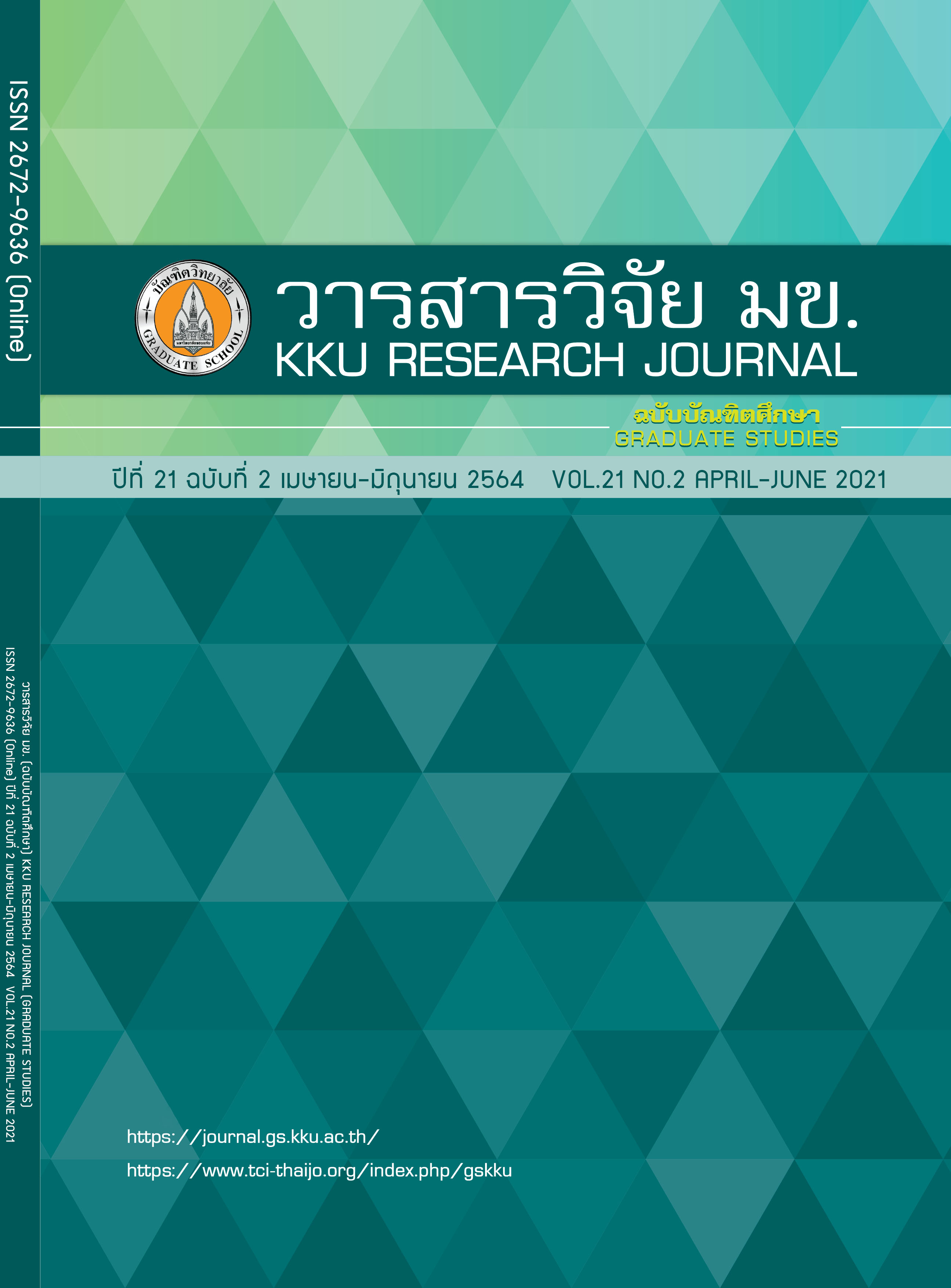Effectiveness of King Bolete Mushroom (Boletus sp.) for Controlling Root-Knot Nematode (Meloidogyne incognita)
Keywords:
Biological control, Root-Knot Nematode, King Bolete MushroomAbstract
Efficacy of King Bolete Mushroom (Boletus sp.) for controlling root-knot nematode (Meloidogyne incognita). Fifteen isolates of Botetus sp. TA1, TA 2, TA 3, TA 4, TA5, TA6, TA7, TA8, TA9, TA10, TA11, TA12, TA13, TA14 andAK15 were collected from mushroom stalk, Sesbania forest in Phra Nakhon Si Ayutthaya Province in September 2018-2020. In addition, the efficiency of king bolete mushroom on the infection of egg mass stage of root-knot nematode, Meloidogyne incognita that 5 isolates TA6 , TA 9 , TA 11 , TA 13 and AK 15 provided, significantly highest infective efficiency than the control. The infective were 100 % respectively.
References
Shahbaz MU, Mukhtar T, Haque MI, Begum N. Biochemical and serological characterization of Ralstonia olanacearum associated with chilli seeds from Pakistan. Int J Agric Biol. 2015; 17(1): 31-40.
Aslam MN, Mukhtar T, Ashfaq M, Hussain MA. Evaluation of chili germplasm for resistance to bacterial wilt caused by Ralstonia solanacearum. Australas Plant Pathol. 2017; 46(3): 289-292.
Aslam MN, Mukhtar T, Hussain MA, Raheel M. Assessment of resistance to bacterial wilt incited by Ralstonia solanacearum in tomato germplasm. J Plant Dis Prot. 2017; 124(6): 585-590.
Fateh FS, Mukhtar T, Kazmi MR, Abbassi NA, Arif AM. Prevalence of citrus decline in district Sargodha. Pak J Agric Sci. 2017; 54(1): 9-13.
Trudgill DL, Blok VC. Apomictic, polyphagous root-knot nematodes: exceptionally successful and damaging biotrophic root pathogens. Annu Rev Phytopatholo. 2001; 39: 53-77.
Ismail AE. Growing Jatropha Curcas and Jatropha Gossypiifolia as a Interculture with Sunflower for Control of Meloidogyne Javanica in Egypt. International Journal of Sustainable Agricultural Research. 2014; 1(2): 39-44.
Cook RJ, Baker KF. The Nature and Practice of Biological of Pathogens. The American Phytopathological Society St. Minnesota; 1983.
Jalata P. Biological control of nematode, Sasser JN, Carter CC, editor. An advanced treatise on Meloidogyne Volume II: Methodology. USA. Dept Plant Pathol. North Carolina State Univ. 1985; p. 303-304.
Khun-in A. The Influence of Some Mushrooms on Root-knot Nematode Meloidogyne incognita [MSc thesis]. Nakhon Pathom: Kasetsart University; 2005. Thai.
Saeng-ngoen K, Yutim B. Effect of Concentrated Liquid Bolete Mushroom (Boletus colossus Heim.) on Growth and Yield of Hybrid Chilli (Capsicum annuum var. Super Hot). Songklanakarin J Pl Sci. 2018; 5(3): 1-8. Thai.
Verasathiean S, Tangkijchote P, Wanichkul K. Nutrients Affecting Seedling Growth of Eucalyptus after King Bolete Spawn Inoculation. Agricultural Sci J. 2010; 41 Suppl 3/1: S201-204. Thai.
Khun-in A, Sukhakul S, Chamswarng C, Tangkijchote P, Sasnarukkit A. Culture filtrate of Pleurotus ostreatus isolate Poa3 effect on egg mass hatching and juvenile 2 of Meloidogyne incognita and its potential for biological control. J ISSAAS. 2015; 21(1): 46-54.
Heydari R, Pourjam E, Mohammadi Goltapeh E. Antagonistic effect of some species of Pleurotus on the root-knot nematode, Meloidogyne javanica in vitro. J Plant Pathol. 2006; 5(2): 173-177.
Rajchawong N. Efficacy of the Filtrate from King Bolete Mushroom Mycelia (Boletus colossus Heim.) for Controlling Root-Knot Nematode (Meloidogyne incognita) of Chili [B.S. thesis]. Nakhon Pathom: Kasetsart University; 2010. Thai.
Alves MJ, Ferreira IC, Froufe HJ, Abreu RM, Martins A, Pintado M. Antimicrobial activity of phenolic compounds identified in wild mushrooms SAR analysis and docking studies. J Appl Microbiol. 2013; 1-12.
Kim MY, Seguin P, Ahn JK, Kim JJ, Chun SC, Kim EH. Phenolic Compound Concentration and Antioxidant Activities of Edible and Medicinal Mushrooms from Korea. J Agric food chem. 2008; 56: 7265-7270.
Vaquero MJR, Alberto MR, Manca de Nadra MC. Antibacterial effect of phenolic compounds from different wines. Food Control. 2007; 18: 93-101.
Tiwari PK, Kumar M, Kaur H. Phytochemical screening and Extraction: A Review. IPS. 2011; 1: 98-106.
Warcup JH. Ectomycorrhizal Associations of Australian Indigennous Plants. New Phytologist. 1980; 85: 531-535.
Ackerson JP. Soil Sampling Guidelines. Ag purdue edu Agry. 2018.
Biodiversity-based Economy Development Office. Mushroom biological property list. Biodiversity Digital Library. 2013. 376 p. Thai.
McClure MA, Kruk TH, Misaghi I. A method for obtaining quantities of clean Meloidogyne eggs. J Nematol. 1973; 5(3): 230.
Gortari MC, Hours RA. Fungal chitinases and their biological role in the antagonism onto nematode eggs. A Rev Mycol Progress. 2008; 7(4): 221-238.
Sun MH, Gao L, Shi YX, Li BJ, Liu XZ. Fungi and actinomycetes associated with Meloidogyne spp. eggs and females in China and their biocontrol potential. Invertebr Pathol J. 2006; 93(1): 22-28.
Barron GL, Thorn RG. Destruction of nematodes by species of Pleurotus. Can J Bot. 1987; 65(4): 774-778.
Contina JB, Danduran LM, Knudsen GR. Use of GFP-tagged Trichoderma harzianum as a tool to study the biological control of the potato cyst nematode Globodera pallida. Appl Soil Ecol. 2017; 115: 31-37.
Zhang S, Gan Y, Ji W, Xu B, Hou B, Liu J. Mechanisms and characterization of Trichoderma longibrachiatum T6 in suppressing nematode (Heterodera avenae) in wheat. Front Plant Sci. 2017. 15(8) 1491.
Barron GL. Pleurotus toxin[Internet]. 2003. Barron Website. Available from http://www.uoguelph.ca/ ~gbarron/Zbiodiversity/pleutox.htm



